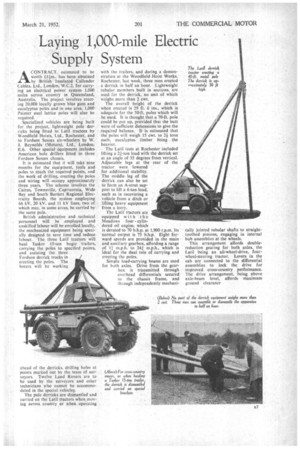Laying 1,000-mile Electric Supply System
Page 41

If you've noticed an error in this article please click here to report it so we can fix it.
ACONTRACT, estimated to be worth it ?Ai., has been obtained by British Insulated Callender Cables, Ltd., London, W.C.2, for carrying an electrical power system 1,000 miles across country in Queensland, Australia. The project involves erecting 20,000 locally grown blue gum and eucalyptus poles and in one area, 1,000 Painter steel lattice poles will also be required.
Specialized vehicles are being built for the projcct, lightweight pole derricks being fitted to Latil tractors by Woodfield Hoists, Ltd., Rochester, and to Fordson Sussex six-wheelers by W. J. Reynolds (Motors), Ltd., London, E.6. Other special equipment includes American hole drillers fitted to three Fordson Sussex chassis.
It is estimated that it will take nine months for the equipment, tools and poles to reach the. required points, and the work of drilling, erecting the poles and wiring will occupy approximately three years. The scheme involves the Cairns, Townsville, Capricornia, Wide Bay and South Burnett Regional Electricity Boards, the system employing 66 kV, 20 kV, and 11 kV lines, two of which may, in some areas, be carried by the same pole.
British administrative and technical personnel will be employed and unskilled labour will be en rolled locally, the mechanized equipment being specially designed to save time and reduce labour. The three Latil tractors will haul Tasker 15-ton bogie trailers, carrying the poles to specified points, and assisting the three Fordson derrick trucks in erecting the poles. The borers will be working ahead of the derricks, drilling holes at points marked out by the team of surveyors. Twelve Land Rovers are to be used by the surveyors and other technicians tvho cannot be accommodated in the special vehicles.
The pole derricks are dismantled and carried on the Latil tractors when moving across country or when operating with the trailers, and during a demonstration at the Woodfield Hoist Works, Rochester, last week, three men erected a derrick in half an hour. Lightweight tubular members built in sections, arc used for the derrick, no unit of which weighs more than 2 cwt.
The overall height of the derrick when erected is 29 ft. 6 ins., which is adequate for the 50-ft. poles which will be used. It is thought that a 70-ft. pole could be put up, provided that the butt were of sufficient dimensions to give the required balance, it is estimated that the poles will weigh 15 cwt. to 2i tons each, eucalyptus timber being the heavier.
The Latil tests at Rochester included lifting a 2.1-ton load with the derrick set
at an angle of -35 degrees from vertical. Adjustable legs at the rear of the tractor were lowered for additional stability. The middle. leg of the derrick can also be set to 'form an A-strut sup• poit to lift a 6-ton load, such as in recovering a vehicle from a ditch or lifting heavy equipment from a lorry.
The Latil tractors are equipped with the Meadows four cylindered oil engine, which
• is derated to 70 b.h.p. at 1,900 r.p.m. Its normal output is 75 b.h.p. Eight forward speeds are provided in the mainand auxiliary gearbox, affording a range of -11 m.p.h. to 242 m.p.h., which is ideal for the dual role of carrying and erecting the poles.
Simple load-carrying beams are used for both axles. Drive from the gear . box is transmitted through overhead differentials secured to the chassis frame, and through independently mechani cally jointed tubular shafts to straight. toothed pinions, engaging in internal hub assemblies at the wheels.
This arrangement affords doublereduction gearing for both axles, the Latil being an all-wheel-drive, fourwheel-steering tractor. Levers in the cab are connected to the differential assemblies to lock the drive for improved cross-country performance. The drive arrangement, being above axle-beam level, affords maximum ground clearance




















































































